A chicken coop protects chickens from bad weather and predators. At the same time, it creates a warm and safe place for them to lay eggs.
Having a good chicken coop is important to growing healthy chickens that lay eggs. Chicken coops come in a wide variety of styles. Yours doesn’t have to be either simple or boring.
Thinking of buying or building a chicken coop? Think beyond its practical value. The right chicken coop can be a cool addition to your backyard!
But before we get to that, let’s not forget that chickens came before the chicken coop. A much clearer debate than the old one of the egg versus the hen.
Chicken Breeds for Chicken Coops
Paying attention to the differences between chicken breeds can help you understand what sort of chicken coop you need. More exactly, you want to look at temperament, egg production, and looks.
Some chicken breeds dislike small confined spaces. In other words, they are not the ideal choice for a small chick coop.
Other breeds lay consistently more eggs than others. You don’t want to expect too many eggs from a breed grown primarily for its meat.
Learn more about the different chicken breeds to make an informed choice. Cluck! Cluck!
Araucana Chickens
The lively Araucana chickens don’t have much of a tail. But they have cool tufts at the cheeks and come in many colors including silver, buff, golden, and white.

Their distinct feathering makes them a cheerful sight in most chicken coops. Add to that their energy, and you’ll want at least a few.
How many eggs: A typical Araucana hen will lay around 150 eggs every year. Not the busiest layer, true, but you’ll love its blue-shelled eggs!
Ameraucana Chickens
Not to be confused with Araucana, this bearded and muffed breed comes in eight colors including white, silver, buff, blue, and black. A light breed, Ameraucana chickens are friendly and docile and have good foraging skills.

They don’t mind wintery weather provided you can shelter them from drafts. Also, they get along with other species quite well.
How many eggs: Ameraucana chickens lay up to 300 light blue eggs every year. That makes them great layer chickens.
Australorp Chickens
Can you guess where this breed comes from? You may think Australorp chickens adventurous. But in fact, they have a gentle temperament.
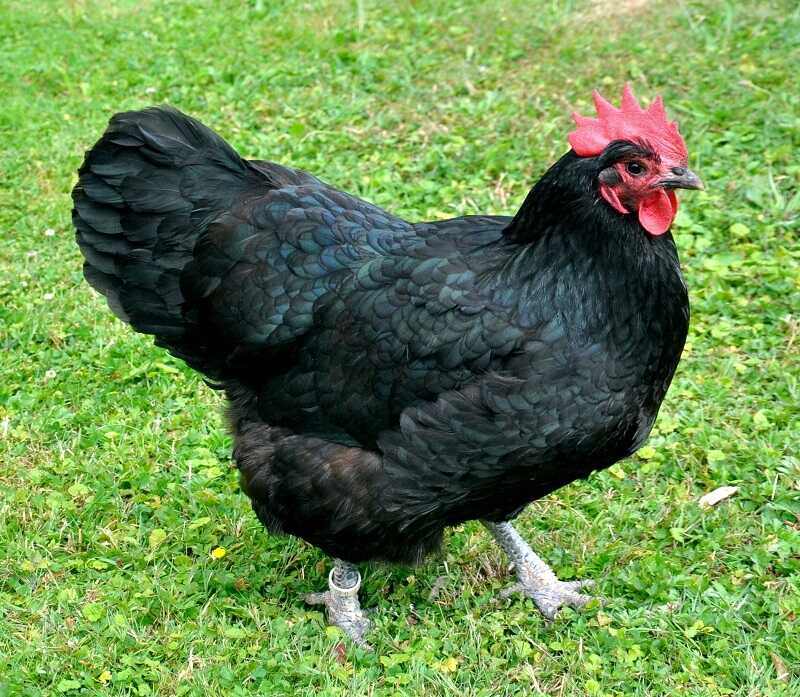
That means they won’t mind growing in a small chicken coop. Also, you’ll love their shiny black plumage and awesome egg production.
How many eggs: Australorp hens are some of the most prolific. They can lay 300 light-brown eggs every year. That’s twice more than other breeds.
Buff Orpington Chickens
The golden-yellow Buff Orpington is a cold-resistant breed from England. This heavy-set breed has had some rough years. At some point, it even became endangered.

But now you can find it without much trouble. If you live in a colder area, it could be a good breed for you. But keep in mind that you’ll still have to insulate your chicken coop.
How many eggs: You can expect around 150 large brown eggs every year. But don’t be surprised if Buff Orpington hens take it easier during the summer months.
Leghorn Chickens
Hailing from Italy, this enduring breed has a friendly and spirited personality. That makes it a good match for most chicken coops.

White Leghorn is a particularly prized variety. It’s all white save for its bright-red comb which it wears like a mark of pride.
Leghorns can get noisy, so you may want to keep them in a chicken coop at a reasonable distance from the house.
How many eggs: The average Leghorn hen lays around 200 medium-sized eggs annually.
Barred Rock Chicken
Also known as Plymouth Rock, this long-lived and courteous breed is great for beginners. It’s known for its easy nature, which makes it suitable for most coops.

This breed is easy to spot thanks to its black-and-white feathers. But you can also find varieties with colored markings.
How many eggs: Barred Rock hens are dependable layers—you can expect around 200 light-brown eggs annually. Not bad for an easy-going breed!
Naked Neck
Want a more distinctive breed for your chicken coop? You can’t go wrong with this one. Originating in Transylvania, the Naked Neck may look like a cross between a chicken and a turkey.

But that suspicion is unfounded. There’s nothing turkey-ish about this quirky breed. They just have naked necks, that’s all.
How many eggs: Expect up to 150 eggs per year from a well-fed, happy Naked Neck chicken. That’s an omelet about once or twice a week.
Rhode Island Red Chicken
Despite its name, this chicken breed is more often rusty or black than red. Rhode Island Reds are hardy and won’t mind some rain and snow.

Also, you’re looking at a pretty easy-going breed that can get along with pets and kids. You can raise this breed for both meat and eggs. The hens are dependable layers.
How many eggs: It’s not uncommon for Rhode Island Red hens to lay around 250 medium-sized brown eggs every year.
Silkie Chicken
Blame it on their fluffy plumage, but silkie chickens stand out. These bantam chickens don’t take much space. But they attract attention like few other breeds can.

You’ll fall for their puffy plumage and charming ways. Despite their precious looks, they’re not all that haughty, which makes them a good breed for beginners.
How many eggs: Silkie chickens are not the most productive egg layers—expect only around 100 eggs a year.
Sussex Chicken
Bigger than most, Sussex chickens come in many different color combinations. They are laid-back and curious and tend not to make much of a mess despite their size.

This breed is social and mingles easily with other breeds. Overall, it’s a great choice for most chicken coops.
How many eggs: Sussex chickens can lay over 250 eggs annually, making them one of the most productive breeds.
Chicken Food & Feed for Coops
Chickens are omnivores. That means they’ll eat just about anything you throw at them, including grains, fruits, vegetables, and table scraps.
But just because chickens have eager beaks doesn’t mean you can throw anything eatable in their coop. To keep them healthy, choose chicken food that gives them the right mix of nutrients.
More specifically, chickens need:
- Plant-based protein for growth
- Vitamins and minerals to keep them healthy
- Carbohydrates for energy
- Enzymes to facilitate nutrient absorption
- Fats for vital cell function and vitamin absorption
Sounds a bit complicated? It’s not.
Good quality chicken feed contains all of these mixed in the right quantities. The basic rule is to choose a chicken feed that covers all the nutritional needs of your chickens.
Important: Unlike chickens allowed free range, chickens in a coop don’t get the opportunity to gather any nutrients from the environment. So, it’s crucial to ensure that the feed has them covered. Hens need around 20 grams of protein every day to lay an egg!

What About Chicken Treats?
In addition to chicken feed, you want to give your chickens treats now and then. Treats add diversity to their diet and supplement their nutrition. And, of course, it just keeps them happy!
But chicken treats are quite different from your idea of a treat. Sweets are out of the question. Here are some of the healthy and delicious goodies you can give them now and then.
- Corn
- Apples
- Pears
- Oatmeal
- Cooked pasta
- Ginger
- Watermelon
- Pumpkin
- Meat scraps
- Cottage cheese
- Celery scraps
- Mealworms
Important: You don’t want to throw treats too often in the chicken coop—definitely not every day! Treats can unbalance their diet by filling their stomachs without providing the nutritional value of chicken feed. Give chicken treats only 1-3 times a week.
What Chickens Shouldn’t Eat
Now, what about the food you shouldn’t throw into the chicken coop? Like never?
- Avocadoes because their pit and peel contain persin, a compound that’s toxic to birds.
- Processed foods including junk food and meal leftovers because they have high fat and sugar levels and few nutrients.
- Onions because they contain thiosulphate, a toxic compound for chickens.
- Green potato skins because they contain the toxic compound solanine. Boiled potatoes are fine.
- Any food with chocolate because it contains theobromine, the same compound that’s unhealthy for dogs.
- Raw eggs, not because it’s bad for them, but because it can encourage chickens to eat their own eggs.
- Rotten food because well, it’s just rotten!
How to Choose Chicken Feed
Choosing the right chicken feed for your chicken coop gets easier when you pay attention to a few key things.

Use of chicken feed
Choose chicken feed depending on the age of your chicken coop brood.
Starter chicken feed gets your baby chickens going with its very high protein content (20-24%). It’s the smallest in size and easiest to peck.
Layer chicken feed provides a balanced mix of protein, nutrients, and vitamins. It’s the feed you’ll be regularly using.
Protein
High protein chicken feeds (>16%) are great for layer chickens and keeping most chicken breeds healthy and strong.
Fiber
Fiber is important for gut health and layer chickens need it especially. Look for chicken feed with a fiber content of around 7 to 7.5%.
Corn/Corn-Free
Chickens love corn. But it can carry allergens. To minimize risks, buy corn-free chicken feed and give corn as a separate treat to your chickens.
Soy/Soy-Free
Soy is a common ingredient in most chicken feeds. There’s nothing wrong with it, but some chicken coop lovers feel that it doesn’t provide as much protein value as other crops.
GMO/NON-GMO
Non-genetically modified chicken feed is healthier for everyone—chickens and humans included. Unless it says on the label that the chicken feed is non-genetically modified, you could be buying GMO feed!
Types of chicken feed
Chicken feed can have different textures depending on whether it’s processed or not and how it is processed.
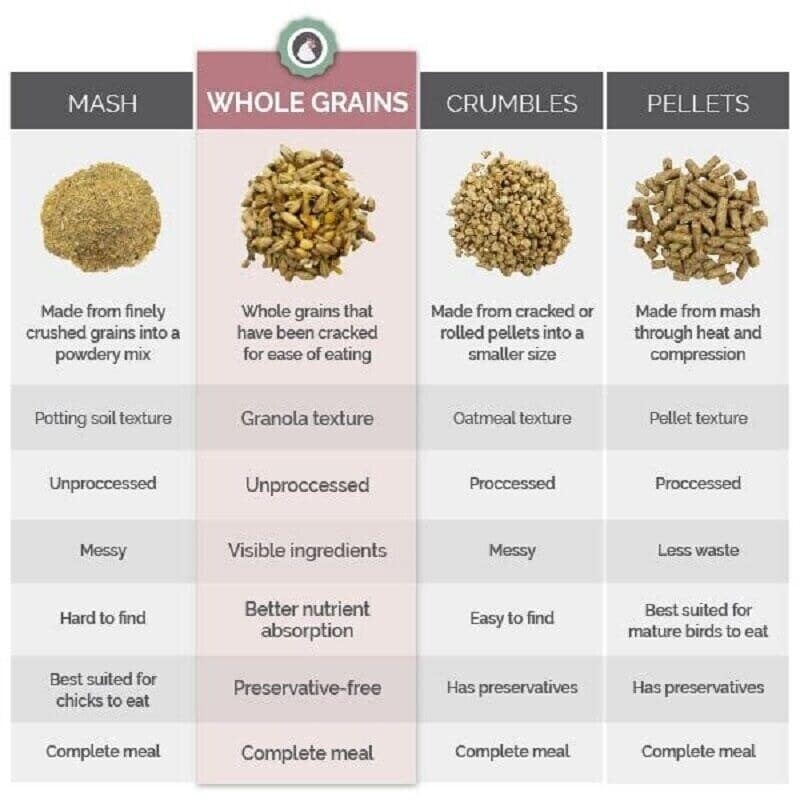
- Mash is loose and unprocessed and so easy to digest. You can combine it with water.
- Crumble is like oat-meal – coarser than mash and often easier to handle.
- Pellets provide more texture than crumble and hold their texture nicely. They’re easy to manage and serve.
- Whole grains are cracked so chickens can eat them more easily.
Bag Size
Bigger is not always better if you have back problems!
The Best Chicken Feed for Coops
Chicken feed will form the basis of your chickens’ healthy growth and development. So, you don’t want to make any compromises.
Buy the best feed you can afford to grow the best chickens!
Manna Pro Layer Non-GMO & Organic Pellet Feed for Laying Hens
Designed for layer chickens, this organic pellet feed contains all the nutrients and vitamins hens need to lay big eggs. It’s easy to eat whether you use a chicken feeder or prefer to feed your chickens manually.
Ingredients include corn, soybean, barley, oats, cane molasses, and flax meal. Overall, it’s a dependable feed if you want to build a chicken coop for layer chickens.
- Size: 30lbs
- Protein layer: 16%
- Complete feed: Yes
CountryMax Egg Layer Pellet Chicken Feed
You’re looking at a high-protein, high-vitamin mix here. With this feed, you don’t have to worry about adding in any supplements.
But bear in mind that it was made to optimize egg production. If you’re growing your chickens for the meat, consider other feeds.
- Size: 50lbs
- Protein layer: 16%
- Complete feed: Yes
Purina Layena + Omega-3 Feed
Omega-3 fatty acids are super healthy, but store-bought eggs contain only about 50mg. Keeping your chickens on this feed increases omega-3 fatty acids to 250mg per large egg.
Key ingredients include probiotics, essential amino acids, and marigold extract. The latter gives egg yolks a richer color. Overall, this can be an inspired choice for getting better quality eggs from layer chicken breeds.
- Size: 40lbs
- Protein layer: 16%
- Complete feed: Yes
Mile Four Certified Organic Chicken Feed
Back problems? No worry. This organic, non-GMO, soy and corn free layer chicken feed comes in a manageable 19lbs bag. The whole grain texture provides optimal nutrient absorption while preventing crumbling and mashing.
It’s got the right mix of protein, fat, and fiber to help you grow bountiful chickens and happy hens. You’ll also like the moisture-free bag.
- Size: 19lbs
- Protein layer: 16%
- Complete feed: Yes
Prairie’s Choice Non-GMO Backyard Chicken Feed
This balanced and nutritious feed is great for large, nutrient-demanding breeds. Key ingredients include corn, soy meal, calcium, and essential vitamins.
Crumbles texture makes it less likely for chickens to choke on them. They’re also quite fun to peck! Throw a handful of these into your chicken coop and you’ll see just what we mean.
- Size: 25lbs
- Protein layer: 16%
- Complete feed: Yes
Scratch and Peck Naturally Free Organic Layer Feed for Chickens
This complete scratch feed for chickens is USDA certified organic and natural. Avoiding genetically modified chicken feed can keep both your chickens and your family healthy.
In addition, this feed is raw and unprocessed and doesn’t contain any soy or corn.
- Size: 25lbs
- Protein layer: 16%
- Complete feed: Yes
Small Pet Select Sustainable Chicken Scratch
Another corn-free, soy-free chicken scratch comes from Small Pet Select. This one has a minimum of 12% crude protein and a maximum of 7.5% crude fiber. It’s great for treats.
This mix encourages pecking and scratching and can keep your chickens occupied for long stretches at a time. Another reason you may want to choose this one is that it uses only ingredients sourced in the Pacific Northwest.
- Size: 25lbs
- Protein layer: 12%
- Complete feed: No
Chicken Coop Ideas & Plans
You know what chicken breed you want, and you know what chicken food to stack. Now what’s the image that springs to mind when you think of a chicken coop?
An enclosure built out of plywood and wire mesh someplace in your backyard? Like we said, you don’t have to settle for an average chicken coop.
Building a chicken coop isn’t a God-given skill. It’s not a question of whether you got it or not, either. You can do it with essential materials and tools. You just need a bit of patience and, more importantly, a plan – a chicken coop plan that is.
How to Build a Chicken Coop
Before you look at chicken coop plans, consider the basics. It will help you clarify what you need and that will make choosing a plan easier. So, where should you start?
1. Calculate Space
Chickens don’t like a living in a cramped coop. They will lay fewer eggs, start pecking each other and eventually get sick. To say nothing of the smell!
How much space each chicken needs depends on their breed and whether they get any outdoor time.
It goes without saying that bantam chickens require less space. But for any other breeds, calculate coup space based on their requirements at maturity.
Basic math is all you need to calculate the optimal space for your coop.
For normal breeds
- 3-4 square feet per chicken for chickens that get to roam your backyard or another open space. If you plan to grow 5 chickens, that means you’d need a chicken coop of at least 20 square feet (5×4).
- 10 square feet per chicken for chickens that stay cooped up all the time. If you plan to grow 5 chickens permanently in the coop, build them a chicken coop that provides at least 50 square feet of space.
For bantam breeds
- 2 square feet per chicken that get to cluck and peck outdoors. If you plan to raise 6 Silkies, you’d need a 12 square feet chicken coop (2×6).
- 5 square feet per bantam chicken that stay in the coop all day. For 6 silkies that would mean you’d need a 30 square feet coop.
Note: This is the bare minimum. It’s always better to provide more space if you can.
What if you don’t have that much space?
You can get away with less than 3 square feet per chicken if the chickens can stay outdoors all the time. In other words, very small chicken coops are good only for your feathery friends to sleep in them!
2. Choose the Location
Anywhere there is free space is usually not the best location for a new chicken coop. The location of the chicken coop isn’t just a matter of convenience.
It has a big impact on the health of the birds. To say nothing of your relations with neighbors.
Here’s what you should consider when choosing the location for your chicken coop.
- Your chickens need natural sunlight. But they shouldn’t be exposed to it all day. This is all the more important for chickens that will remain most of their lives in the coop.
- Chickens like a nice flow of air in their coop. But they don’t like being at the mercy of the wind!
- You need to be able to easily access and clean the coop. On most days, you’ll probably be checking it at least twice to gather eggs or to clean.
- A chicken coop can smell and get noisy despite all your precautions. You don’t want it under your window—or your neighbor’s.
3. Choose the Extras
The roof and the walls are a start, but chickens need more than essential protection from the elements. Here’s a list of the basic additions you’ll want in your chicken coop.
- Feeder
- Waterer
- Perch where the chickens can sleep
- Nesting box above ground, at least one for each two hens
- Window/ventilation
- Dust box for the chickens to bathe and stay clean
- Lighting to boost egg production in winter
- Outdoor fence area where the chickens can move (the run)
You’ll have to buy most of these separately.
DIY Chicken Coop Ideas
We’ve covered the basics, so now let’s explore some backyard chicken coops plans. These ideas for a chicken coop can inspire you to build your own. It’s not hard and you don’t have to spend all that much money.
Discover them now!
A-Frame Chicken Coop
Chicken coop ideas don’t get easier than this! The A-frame chicken coop is small and inexpensive and looks pretty cool, too. And the best part is that you can move it around.

- Difficulty level: Beginner
- Cost: Low
Portable Chicken Coop
Portable chicken coops are great if you don’t want to grow many chickens at a time. You can make one from lightweight materials and adapt it to the size of your backyard.
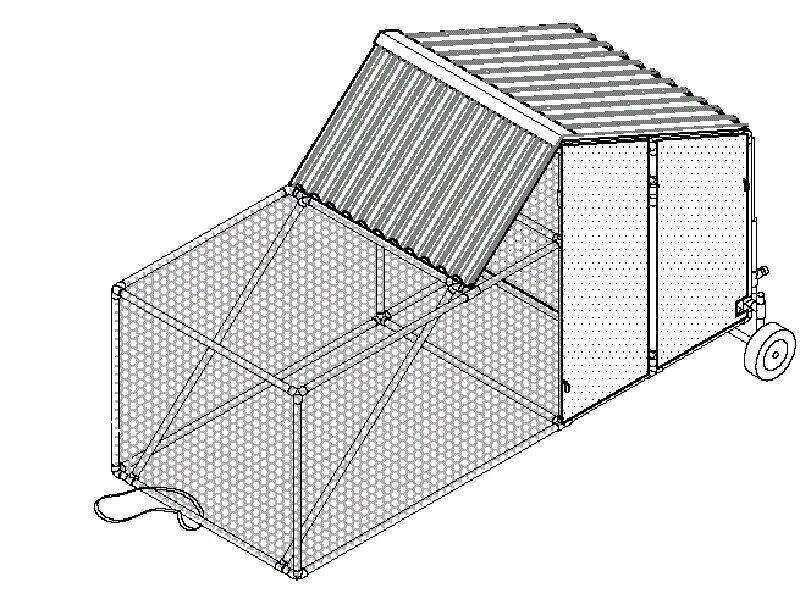
- Difficulty level: Beginner
- Cost: Low
Easy DIY Chicken Coop
Save time and materials building a super easy DIY chicken coop. With this design, you don’t have to worry about costly materials.

- Difficulty level: Beginner
- Cost: Low
Shed Chicken Coop
If you’re willing to put in more work, a shed chicken coop can become a cool addition to your yard. The best part about this chicken coop design is that it enables you to use vertical space to your advantage.

- Difficulty level: Intermediate
- Cost: Moderate
Small Chicken Coop
Most people start with a small chicken coop before expanding it over time. Here’s a design that uses space effectively to provide enough space for a tiny flock. Looks awesome, too!
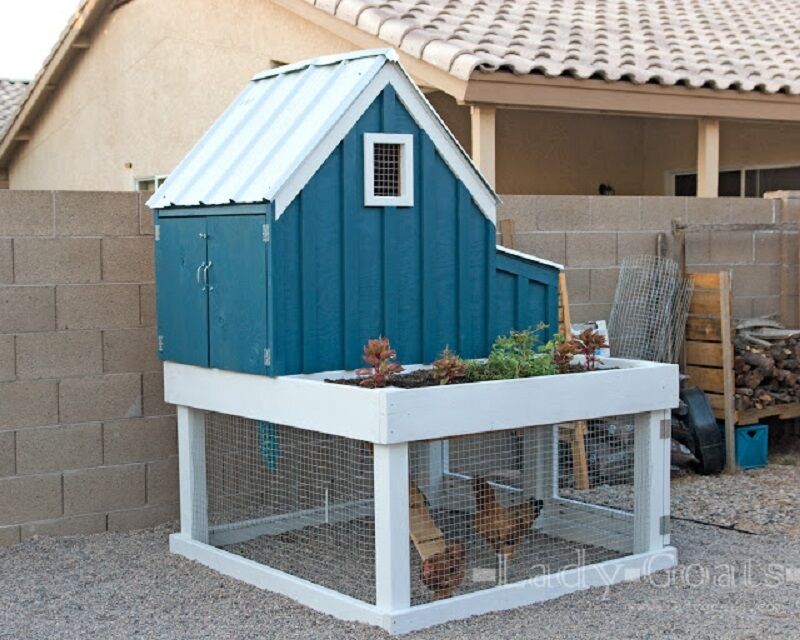
- Difficulty level: Intermediate
- Cost: Moderate
Walk in Chicken Coop
This type of chicken coop takes more space. But this is not space lost but gained—it will make the birds happy, which means better eggs! Discover a cute walk in chicken coop plan.

- Difficulty level: Intermediate
- Cost: High
Chicken Coop with Run
If you don’t plan to let your chicken room your yard, adding a run to your coop is a must. It can make a big difference to their health and keep them stress-free and on friendly terms with each other. Here’s an awesome chicken coop with run.

- Difficulty level: Intermediate
- Cost: Moderate
Homemade Chicken Coop
This homemade chicken coop doesn’t require any fancy materials. You can build it in a few days, and it can last for years. It’s a safe choice if you want to start small.
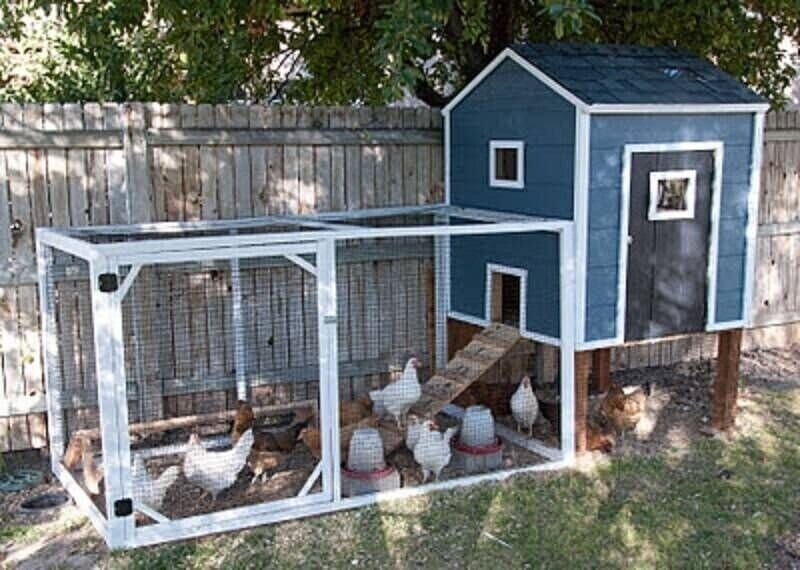
- Difficulty level: Intermediate
- Cost: Moderate
Large Chicken Coop
Planning on growing a lot of layer chickens? If space is not a problem, go for this extra large chicken coop. But bear in mind that you’ll be spending more time cleaning it than most other chicken coops on this list.

- Difficulty level: Hard
- Cost: High
Palace Chicken Coop
Backyard chicken coops don’t get fancier than this palace chicken coop. Whether you live in an urban area or in the country, this is a stunning design that will make your chickens feel pampered and spoiled.

- Difficulty level: Hard
- Cost: High
Chicken Coops for Sale
What if you don’t have the time or the tools to build a chicken coop? You can buy a chicken coop that you only have to assemble.
But weigh your options carefully. There can be a big difference in the build quality and materials of chicken coops for sale. To save you time and help guide your choice, we’ve searched for the best chicken coops for sale now.
Whether you want a small or a large chicken coop, a wood or plastic chicken coop, the following chicken coops got you covered.
SnapLock Formex Large Plastic Chicken Coop
This spacious plastic chicken coop is very easy to set up. It requires no tools. You just have to fit and snap the different components in place. It accommodates up to 6 layer hens or up to 12 bantam chickens.
It’s resistant to water, ultraviolet radiation, and impacts. The double-wall construction provides insulation, so you can keep it outside in all seasons.
Plastic chicken coops can be easier to maintain than wood chicken coops. They can also have a longer lifespan. Still, you have to clean them regularly. Also, avoid placing them in a spot where they’re constantly exposed to the wind and the elements.
What’s included
- 3 roosts
- 4 nesting spots
- Adjustable ventilator
- Removable litter tray for faster cleaning
Large Metal Chicken Coop with Walk In and Run
You’re looking at one of the largest metal chicken coops for sale—it’s 10’x20’x6.4’. Made from galvanized steel, it comes with a quick-connect frame that makes it easy to assemble.
The PCV-coated hexagonal wire mesh gives it a classic chicken coop look while protecting your chickens from predators. Another useful safety feature is the door lock.
If you want a large chicken coop without any bells and whistles, this could be just it. But keep in mind that you’ll have to buy accessories like perches and nests separately.
What’s included
- Water-resistant, anti-ultraviolet Oxford cover
- Installation manual
Little Cottage Company Gambrel Barn Coop 4’x6′
Looking for something fancier? This DIY chicken coop kit lets you set up a charming hen house in no time. It’s great for up to 6-7 chickens.
The panelized wall sections are easy to assemble using the included fasteners. You don’t need to be a DIY master to figure this one out. But you may need help to unload the package—it weighs 820 pounds.
The kit doesn’t include shingles or drip edge. Also, you’ll have to buy paint separately. But the good thing about that is that you can make it any color you want.
What’s included
- Nesting bins with egg laying area
- Ventilation bar
- Chicken ramp
Mini Chicken Coop with Running Tray
But if you don’t got all that much space, don’t worry. This cute mini wooden chicken coop with running tray and resting floor is great for one hen or two bantam chickens.
The above-ground nesting house is the main feature. But there is also a sliding door and ramp for keeping the hen(s) entertained. It’s made from strong wood painted with eco-friendly, waterproof paint. You can keep it outdoors in all seasons.
The detachable wireframe design makes it easy to clean with the water hose. You can also use it as a backup rabbit hutch.
What’s included
- Ventilated window
- Pull-out tray for easy cleaning
- Slide door lock
- Spacious running area
Chicken Coop FAQ
Below our reader’s most asked questions on chicken coops, how to build chicken coops and all the beautiful different types of chickens and hens out there! Don’t hesitate to ask your questions in the comments below, and we’ll try to answer them as fast a chickens lay their eggs…
Are chicken coops stinky?
A chicken coop won’t smell if you clean it regularly, at least two or three times a week. Chickens don’t smell more than other pets.
What is the best way to build a chicken coop?
The best way to build a chicken coop is according to a plan. Factor in how much space each chicken needs (2-4 feet, depending on the breed). You can build a chicken coop from your own materials or buy a pre-assembled kit.
What is needed in a chicken coop?
A good DIY chicken coop has a feeder, a water container, nest boxes, perches, and tray for easy cleaning. Other components are optional.
What do you do with chickens in the winter?
Insulate your chicken coop, minimize drafts, and ensure that the chickens have perches to roost on. Good ventilation is also important!
The Wrap Up
Whatever some folks say, chicken coops are neither messy nor stinky. They provide the sheltered space that your chickens need to grow and lay eggs.
It follows–having a spacious, well-equipped chicken coop is crucial to growing healthy and lively chickens.
Whether you opt for a simple design or build a custom DIY chicken coop with lots of extra features, there are plenty of chicken coop ideas out there.
Start with a plan or buy a ready-made chicken coop. Cluck! Cluck!
Uh oh, got rabbits in your garden too? Here’s our rabbit cage guide for you!

Hello ,
We are wanting to buy the Farm House chicken plans and can’t seem to find that on here ?
Thank you !
Hello Angie,
Thank you for your question! You can find the DIY Chicken Coop Plan here.
Best,
Plated Well team